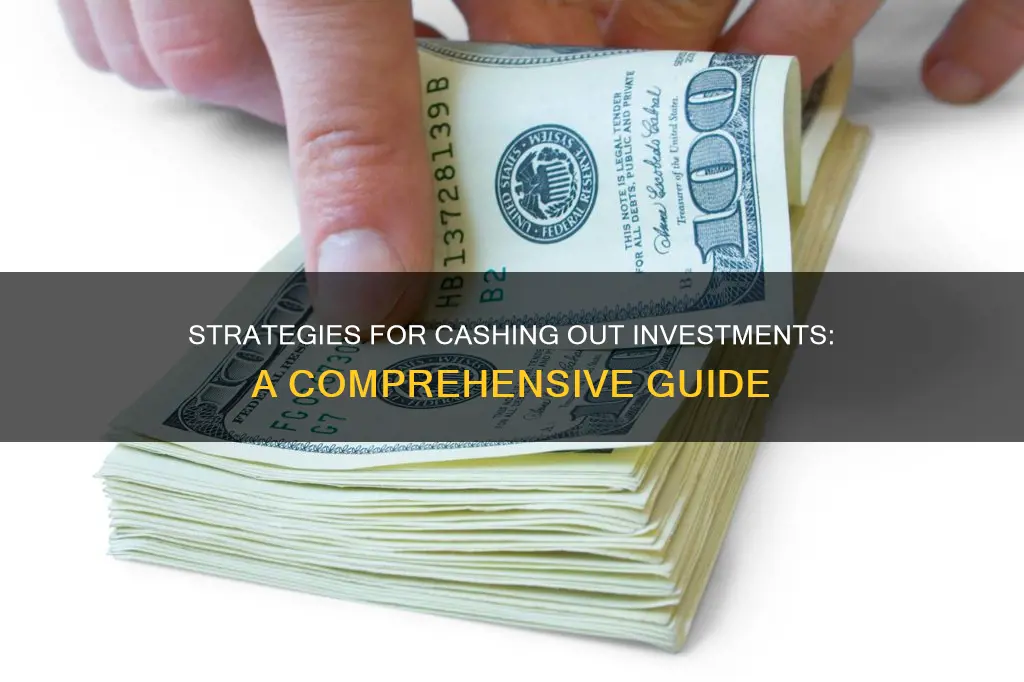
Cashing out of an investment is a complex process with many factors to consider. It is important to understand the nature of the withdrawal, whether it is a one-time withdrawal or setting up a regular income. Withdrawing money from a brokerage account is a common method, but it is important to note that you can only withdraw cash, and selling investments may be necessary to achieve the desired cash amount. When selling stocks, investors should determine their investment goals, access their brokerage account, place a sell order, wait for the sale to be completed, and receive the proceeds. Withdrawing from retirement accounts, such as IRAs or 401(k)s, has additional tax implications and early withdrawal penalties for those under a certain age. Market timing, or attempting to sell before a market downturn, is often unsuccessful, and it is generally recommended to stick to a long-term investing strategy. Before cashing out, it is crucial to evaluate short-term and long-term goals, tax implications, and alternative strategies such as rebalancing a portfolio or shifting to defensive sectors.
| Characteristics | Values |
|---|---|
| Reasons for cashing out | Covering major expenses, reinvesting in other assets, preventing significant losses, day trading, offloading low-performing stocks, emergency funds, retirement |
| Steps to cash out | Determine investment goals, access brokerage account, place sell order, wait for the sale to be completed, receive proceeds |
| Types of sell orders | Market orders, limit orders, stop orders, trailing sell stop orders |
| Factors to consider | Capital gains taxes, investment goals, fees and commissions |
What You'll Learn

Capital gains taxes
When you sell an asset for more than you paid for it, you will make a profit, known as a capital gain, and this is subject to capital gains tax. The Internal Revenue Service (IRS) taxes individuals on capital gains from the sale under certain circumstances.
There are two types of capital gains tax: short-term and long-term. The tax you pay depends on how long you hold the asset before selling it. Assets held for more than a year qualify for the more favourable long-term capital gains tax rates, which range from 0% to 20%, depending on your taxable income and filing status. In contrast, gains on investments held for a year or less are short-term capital gains, taxed at your ordinary income tax rate, which can be as high as 37%.
There are a number of ways to minimize or avoid capital gains taxes:
- Invest for the long term: The lowest capital gains tax rate applies if you hold an investment for more than a year before selling.
- Take advantage of tax-deferred retirement plans: When you invest through a retirement plan, such as a 401(k) or IRA, your money grows without being subject to immediate taxes.
- Use capital losses to offset gains: If you experience an investment loss, you can decrease the tax on your gains on other investments.
- Watch your holding periods: If you are selling a security that you bought about a year ago, it may be worth waiting a few days or weeks to qualify for long-term capital gains treatment.
- Pick your cost basis: When you've acquired shares at different times and prices, you need to determine your cost basis for the shares you sell. While investors typically use the first in, first out (FIFO) method, there are other methods available, including last in, first out (LIFO), dollar-value LIFO, specific share identification, and average cost (only for mutual fund shares).
It's also worth noting that capital gains taxes may not apply if you sell your primary residence, as there is a special exclusion for this. If you've owned and lived in your home for at least two of the previous five years, you can exclude up to $250,000 of capital gains from your income ($500,000 for married couples filing jointly).
Investments and Cash Equivalents: What's the Real Difference?
You may want to see also

Investment goals
Time Horizon
The time horizon of your investment goal is crucial. If you're investing for a long-term goal like retirement, you'll generally want to take a different approach compared to a shorter-term goal. Long-term investments are typically focused on growth over a longer period, whereas shorter-term goals may require a more conservative approach to ensure the funds are available when needed.
Risk Tolerance
Your risk tolerance will also play a role in your investment goals. If you're investing for retirement, you may be able to take on more risk, especially when you're younger and have a longer time horizon. As you get closer to retirement, you may want to shift your focus to capital preservation and consider lower-risk options.
Tax Implications
Tax implications can significantly impact your investment goals. For example, if you sell investments for a gain, you'll likely need to pay capital gains taxes. On the other hand, selling investments for a loss may generate tax savings. Understanding the tax implications of your investments can help you make more informed decisions about when to buy and sell.
Compounding and Reinvestment
Compounding and reinvestment are powerful tools for growing your investments over time. When you reinvest your earnings, you give them the opportunity to generate even more returns. This can be particularly beneficial for long-term investment goals, as it allows you to maximize your gains over time.
Emergency Funds and One-Time Expenses
It's important to distinguish between investments for long-term goals and funds set aside for emergency or one-time expenses. Emergency funds should be readily accessible and held in safe, liquid assets like high-yield savings accounts. This ensures that you have the necessary funds when unexpected expenses arise.
In summary, when considering cashing out of an investment, carefully evaluate your investment goals, time horizon, risk tolerance, tax implications, and the potential benefits of compounding and reinvestment. Seeking advice from a financial professional can also help you make more informed decisions about when and how to cash out of your investments.
Cash App Investing: Are There Any Fees Involved?
You may want to see also

Brokerage accounts
There are two main types of brokerage accounts: cash accounts and margin accounts. The difference between them is how and when you pay for your investments. With a cash account, you must pay for the purchase in full. With a margin account, you can borrow money from a brokerage firm to buy securities.
When you open a brokerage account, the firm typically asks you to select a cash management program for uninvested cash in your account. Some cash management programs let you pay your expenses directly or provide you with a debit card and check-writing capabilities.
If you want to withdraw money from a brokerage account, you will need to log in to your account on your broker's website and go to the transfers page. You can then choose the amount and the withdrawal method. With most online stock brokers, your options are a transfer to a bank account, a physical check, or a wire transfer for an additional fee.
It's important to note that you can only withdraw cash from your brokerage account. If you want to withdraw more than you have available as cash, you will need to sell stocks or other investments first. After selling stocks, you must wait for the trade to settle before withdrawing money, which typically takes two business days. You will also owe taxes after selling stocks if you've made a profit.
Withdrawing money from a retirement account, such as an IRA or 401(k), involves additional rules and taxes. You will need to pay income tax on the amount withdrawn, and there may be early withdrawal penalties if you are under a certain age.
Overall, withdrawing money from a brokerage account is not as fast or easy as getting money from a bank account. It usually takes a few days for trades to settle and for the funds to transfer to your bank account.
Extra Cash: Where to Invest for Maximum Returns
You may want to see also

Market timing
There are several predictive methods used to guide market timing decisions, including fundamental, technical, quantitative, or economic data. Technical analysts, for example, consider it significant when one moving average crosses over another, and will predict that the trend will continue.
There are several advantages and disadvantages to market timing.
Advantages
- Avoidance of volatility
- Suited to short-term investment horizons
Disadvantages
- Daily attention to markets is required
- More frequent transaction costs and commissions
- Higher tax rates due to short-term capital gains
- Difficulty in timing entrances and exits
Understanding Invested Assets: Does Cash Count?
You may want to see also

Taxes on dividends
Dividends are shares of a company's profits that are distributed to shareholders. They are usually taxable income, and the tax rate depends on your income, filing status, and whether the dividend is qualified or nonqualified.
Qualified Dividends
Qualified dividends are taxed at lower capital gains rates of 0%, 15%, or 20%, depending on taxable income and filing status. To be considered a qualified dividend, the dividend must meet the following criteria:
- It is paid by a U.S. corporation or qualifying foreign entity.
- It is considered a dividend by the IRS (some things that don't count as dividends include premiums paid by an insurance company and annual distributions made by credit unions to members).
- The shareholder has held the underlying security for more than 60 days during the 121-day period that began 60 days before the ex-dividend date (the day by which you must own the stock to receive the dividend).
Nonqualified Dividends
Nonqualified dividends are taxed as income at rates up to 37%. These are ordinary dividends that do not meet the requirements for qualified dividends.
Reporting Dividend Income
After the end of the year, you will receive a Form 1099-DIV or a Schedule K-1 from your broker or any entity that sent you at least $10 in dividends and other distributions. You use this information to fill out your tax return, and you may also need to fill out a Schedule B if you received more than $1,500 in dividends for the year.
Even if you reinvest your dividends to buy more shares, you still need to report them as income. You also need to report dividends from investments you sold during the year.
Cashing Out on Robinhood: A Guide to Withdrawing Your Investments
You may want to see also
Frequently asked questions
You can cash out your stocks by selling them on a stock exchange through a broker. To do this, log in to your brokerage account, place a sell order, wait for the sale to be completed, and then receive the proceeds.
The time it takes to cash out stocks can vary depending on the type of order you place and market conditions. Generally, it can take anywhere from a few seconds to several days for a sale of stocks to be completed. After the sale is completed, the proceeds will be deposited into your brokerage account or sent to you by check.
Yes, there may be capital gains taxes and investment fees or commissions associated with cashing out your stocks. These will depend on the type of brokerage account you have and the location in which you are paying taxes.







